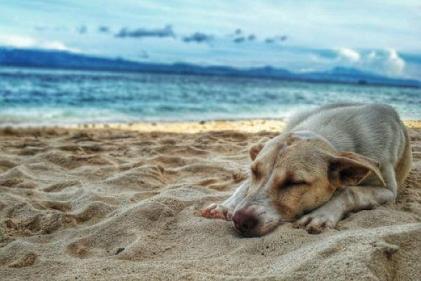 While we know that a well-fed cat is a healthy one, it can be tricky to know exactly what, when and how often to feed our lovable pet.
While we know that a well-fed cat is a healthy one, it can be tricky to know exactly what, when and how often to feed our lovable pet.
Adult cats should eat enough of a high-quality, nutritious food to meet their energy needs and to maintain and repair body tissues.
Here are some tips on how to best feed your feline friend.
Is your kitty an active one?
Cats vary widely in their activity levels. A cat with a 'normal' activity level should receive ‘maintenance’ energy. A pampered cat, who mostly lies around the house, may require ten percent below maintenance, while an active kitty who plays all day may require maintenance plus 20 to 40 percent.
The importance of water
Unless advised otherwise by your vet, your cat should always have free access to fresh, clean water. Water bowls should be cleaned every day.
Unless advised otherwise by your vet, your cat should always have free access to fresh, clean water. Water bowls should be cleaned every day.
Cats are carnivores
All cats require taurine, an amino acid that is important for normal heart function, vision and reproduction. Although most mammals can make taurine from other amino acids in the body, cats cannot. Since taurine is found only in animal-based protein, all cats need meat-based diets to meet their nutritional requirements.
All cats require taurine, an amino acid that is important for normal heart function, vision and reproduction. Although most mammals can make taurine from other amino acids in the body, cats cannot. Since taurine is found only in animal-based protein, all cats need meat-based diets to meet their nutritional requirements.
Consider the weather
As with people, extreme hot or cold weather can increase a kitty’s energy needs. Both keeping warm and keeping cool use up extra energy, so you may wish to consult with your pet’s vet about how often and what to feed your cat when the weather changes.
As with people, extreme hot or cold weather can increase a kitty’s energy needs. Both keeping warm and keeping cool use up extra energy, so you may wish to consult with your pet’s vet about how often and what to feed your cat when the weather changes.
Is your cat in good health?
A cat recovering from surgery or suffering from a disease may have increased nutritional requirements to repair, heal and fight infection. Talk to your vet about adjusting your cat’s diet during periods of illness and recovery.
A cat recovering from surgery or suffering from a disease may have increased nutritional requirements to repair, heal and fight infection. Talk to your vet about adjusting your cat’s diet during periods of illness and recovery.
Two square meals a day
Pet owners should consult with their vets to determine the best feeding schedule and types of foods for their pets. However, as a general rule of thumb, experts recommend that all cats be fed twice daily using the portion control feeding method. To do this, start by dividing the amount suggested on the label of your pet’s food into two meals, spaced eight to 12 hours apart. You may need to adjust portions as you learn your cat’s ideal daily “maintenance” amount.
Pet owners should consult with their vets to determine the best feeding schedule and types of foods for their pets. However, as a general rule of thumb, experts recommend that all cats be fed twice daily using the portion control feeding method. To do this, start by dividing the amount suggested on the label of your pet’s food into two meals, spaced eight to 12 hours apart. You may need to adjust portions as you learn your cat’s ideal daily “maintenance” amount.
Types of feeding
- Portion control feeding entails measuring your pet's food and offering it as a meal, thereby controlling the amount of food that can be consumed. This method is used for weight control programs and for animals who might overeat if fed free-choice. Food can be provided in one or more meals daily.
- Free-choice feeding is also known as "ad lib" feeding or "free feeding." Food is available at all times, as much as the pet wants, whenever the pet wants. Most nursing pets are fed via free choice. This method is most appropriate when feeding dry food, which will not spoil if left out. However, some cats will overeat when fed free-choice, which can result in obesity.
- The timed feeding method involves making a portion of food available for the pet to eat for a specified period of time. For example, you would place food in your cat’s bowl and allow your pet to nosh for 30 minutes. After that time, whatever food the cat has not eaten is removed.
- Free-choice feeding is also known as "ad lib" feeding or "free feeding." Food is available at all times, as much as the pet wants, whenever the pet wants. Most nursing pets are fed via free choice. This method is most appropriate when feeding dry food, which will not spoil if left out. However, some cats will overeat when fed free-choice, which can result in obesity.
- The timed feeding method involves making a portion of food available for the pet to eat for a specified period of time. For example, you would place food in your cat’s bowl and allow your pet to nosh for 30 minutes. After that time, whatever food the cat has not eaten is removed.
The deal with milk
Surprising, milk should not be fed to cats as a treat or a substitute for water. Cats do not possess significant amounts of lactase, the enzyme that breaks down lactose in milk. Feeding too much milk and milk-based products to cats can actually cause them to vomit or have diarrhoea.
Treats in moderation
We all love to give our pets treats. However, treats should be given in moderation and should represent five percent or less of a cat’s daily food intake. The rest should come from a nutritionally complete cat food.
Image via Pinterest.



